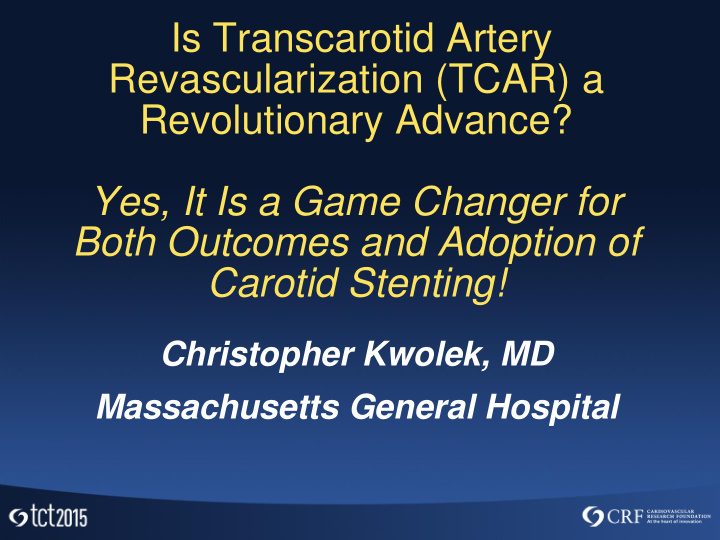



Is Transcarotid Artery Revascularization (TCAR) a Revolutionary Advance? Yes, It Is a Game Changer for Both Outcomes and Adoption of Carotid Stenting! Christopher Kwolek, MD Massachusetts General Hospital
Disclosure Statement of Financial Interest Within the past 12 months, I or my spouse/partner have had a financial interest/arrangement or affiliation with the organization(s) listed below. Affiliation/Financial Relationship Company • • Grant/Research Support Abbott, Silk Road, WL Gore • • Consulting Fees/Honoraria Silk Road • • Major Stock Shareholder/Equity Company Names • • Royalty Income Company Names • • Ownership/Founder Company Names • • Intellectual Property Rights Company Names • • Other Financial Benefit Company Names
There is a single, fundamental premise to treating carotid disease The intent of carotid revascularization is to prevent stroke.
Is TCAR a game changer for outcomes? YES!
ROADSTER Study Outcomes in High Surgical Risk Patients Intention to Treat & Per Protocol Groups Pivotal Group, ITT Pivotal Group, PP High Surgical Risk (N=141) (N=136) S/D/MI 5 3.5% 4 2.9% Major Stroke 0 0% 0 0% Minor Stroke 2 1.4% 1 0.7% Death 2 1.4% 2 1.5% MI 1 0.7% 1 0.7% Stroke & Death 4 2.8% 3 2.2% Per Protocol excludes major protocol deviations All FDA-approved carotid stent systems were used per site preference (Acculink, Xact, Precise, Protégé, Wallstent)
ROADSTER Study Outcomes Key Subgroups High Surgical Risk Age ≥ 75 Symptomatic Female Pivotal ITT N N=66 (47%) N=36 (26%) N=49 (35%) S/D/MI 3 (4.5%) 1 (2.8%) 1 (2.0%) Major Stroke 0% 0% 0% Minor Stroke 0% 0% 0% Death 3.0% 2.8% 2.0% MI 1.5% 0% 0% Stroke & Death 3.0% 2.8% 2.0%
CREST 30-Day Results vs. ROADSTER Standard Surgical Risk vs. High Surgical Risk CREST – 30-Day All Stroke Rates 4.5% 4.1% 4.0% 3.5% Stroke Rate 3.0% 2.3% 2.5% TF-CAS CEA 2.0% [VALUE] TCAR 1.5% 1.0% 0.5% 0.0% 30-Day All Stroke (1) 1. N Engl J Med 2010;363:11-23.
Is TCAR a game changer for adoption? ABSOLUTELY!
US Procedure Volume After 20 years of evolution, CAS is stagnant ~112,500 carotid interventions (2013)* 14% 86% 16K 96K CAS CEA 59% of patients are HSR AND 81% of HSR patients are treated with CEA** *Health Advances, HCUP **Stroke . 2015;46:120-125.
An alternative to CEA remains an unmet need More S/D is not the answer (TF-CAS) 30 Day Stroke and Death in the SVS Vascular Registry n=5,736 7.9% 6.4% 4.8% 3.7% Symptomatic Asymptomatic High Surgical Risk CEA High Surgical Risk CAS J Vasc Surg . 2013 May ; 57(5): 1318 – 1324.
If you Solve the Stroke Problem You Solve the Adoption Problem CREST – 30-Day All Stroke Rates 4.5% 4.1% 4.0% CREST CAS 3.5% 3.0% 2.3% 2.5% 2.0% CREST CEA [VALUE] 1.5% 1.0% ROADSTER TCAR 0.5% 0.0% 30-Day All Stroke (1) 1. N Engl J Med 2010;363:11-23.
Is TCAR too complex? NO!
TCAR is a short and simple procedure • Mini-incision (like EVAR, TEVAR and TAVR) • Local Anesthesia • Direct carotid access avoids arch navigation
TCAR is a short and simple procedure • Dedicated TCAR tool set for direct CCA access • No crossing lesion • No filter - no balloons • Short, direct path to lesion for accurate stent deployment
Procedure Times for TCAR in ROADSTER Compared with TF-CAS and CEA procedure times in CREST* CREST – 30-Day All Stroke Rates 171 180 160 140 120 Minutes 100 74 69 80 60 40 20 0 Procedure Time in Minutes TF-CAS CEA TCAR *Stroke 2012;2408-2416.
Outcomes as a function of the number of patients per physician in CAPTURE 2 TCAR SD Rate = 2.8% CREST-2 Credentialing threshold Gray WA et al. JACC Cardiovasc Interv 2011;4:235-246
How was 1.4% stroke rate (0.7% PP) achieved in ROADSTER? Gen 1 Device 29 operators • 4 operators with >5 TCAR procedures • 1 operator with 1-5 TCAR procedures • 24 operators with NO PRIOR TCAR experience
Summary: TCAR is a game changer TCAR 30-day stroke rate of 1.4% (0.7% PP) TCAR delivers a minimally invasive alternative to CEA , benefits of proximal occlusion TCAR is simple and efficient, the benefits of CAS with a short learning curve
Recommend
More recommend